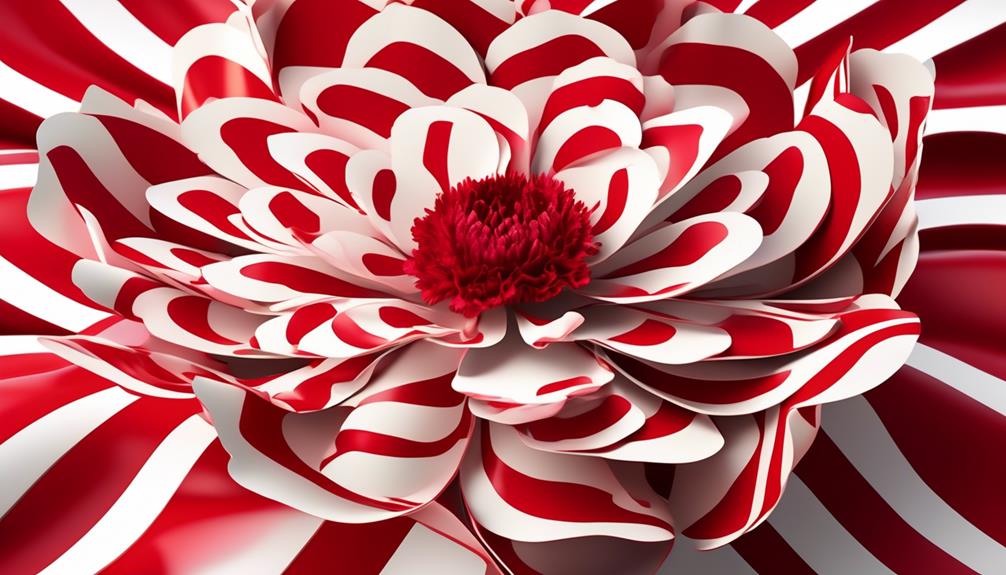Step into the fascinating world of flowers where meanings bloom and stories unfold.
Picture a flower, its petals adorned with delicate stripes that tell a tale of refusal.
The striped carnation, a regaled beauty with a hidden significance, whispers of untold stories and unspoken emotions.
But how did this unique flower come to be? What secrets does it hold?
Join us on this journey as we uncover the captivating story of the striped carnation and explore its symbolic significance that has enthralled hearts throughout history.
Carnation Origins and History
Carnations, known by their scientific name Dianthus Caryophyllus and often referred to as the ‘Flower of Gods,’ have a rich history as one of the world’s oldest cultivated flowers. The origins of the striped carnation are quite fascinating. Legend has it that a woman named Margherita gave a white carnation to her lover before he went off to war. Unfortunately, he was killed, and from the seeds of that white carnation, red and white striped flowers bloomed. These striped carnations became a symbol of refusal, a flower that signifies rejection.
Throughout history, carnations have played significant roles. President William McKinley, for example, always wore a red carnation as a symbol of good luck. Tragically, he gave his carnation to a little girl at the Pan-American Exposition just moments before he was assassinated.
Carnations also have different meanings based on their colors. Red carnations symbolize deep love and affection, while yellow carnations express rejection. White carnations, on the other hand, symbolize innocence and pure love, and they later became the symbol for Mother’s Day.
Story and Origins
After exploring the fascinating origins and history of carnations, it’s time to uncover the captivating story behind the striped carnation.
The striped carnation holds a special place as the regaled flower of refusal. It conveys a gentler form of rejection, often paired with a solid colored carnation to express regret or refusal in a more subtle way.
The story of the striped carnation is rooted in legend and romance. According to the tale, Margherita, a young woman deeply in love with a soldier named Orlando, planted a white carnation in her garden. Sadly, Orlando was killed in war, and his blood stained the white carnation, resulting in the creation of red and white striped flowers.
These striped carnations became a symbol of Margherita’s everlasting love for Orlando, as well as a representation of refusal and the pain of lost love. This story of love, loss, and the birth of a unique flower adds an enchanting layer to the origins and significance of the striped carnation.
Carnation’s Symbolic Significance
To truly understand the significance of carnations, delve into their symbolic meanings and cultural importance.
Carnations aren’t just any flower; they hold a deep symbolic significance. Different colors of carnations carry distinct meanings. For example, red carnations symbolize deep love, pink carnations represent gratitude, and white carnations signify purity and good luck for mothers on Mother’s Day.
However, it’s the striped carnation that holds a unique symbolic significance. When paired with a solid-colored carnation, the striped carnation expresses a gentler form of refusal and regret. This makes it a regaled flower of refusal. Understanding the symbolic meanings of flowers, especially how striped carnations signify the end of a relationship, can help in making informed floral choices for specific occasions.
Moreover, carnations have historical and cultural importance. They trace back to ancient Greece and Rome and are associated with different traditions. For instance, carnations are the official state flower of Ohio and the national flower of Spain.
The etymological and botanical characteristics of carnations further add depth to their symbolic significance, making them suitable for various special occasions.
Carnation’s Hidden Meanings
Delving into the hidden meanings of carnations reveals a deeper understanding of the symbolic significance behind these captivating flowers. While we’ve already explored the general symbolic meanings of different colored carnations, there are additional hidden meanings that are contextually relevant in certain situations.
One such example is the striped carnation, often referred to as the regaled flower of refusal. The striped carnation carries a unique message that isn’t as commonly known as the meanings associated with other colors. This beautiful flower is used to express a gentle form of refusal or regret. When paired with a solid colored carnation, it signifies an apology or a sincere expression of remorse. This hidden meaning adds a layer of complexity to the overall symbolism of carnations.
Understanding these hidden meanings is important, as it allows us to communicate our thoughts and emotions effectively through the language of flowers. Whether it’s expressing deep love and affection with a red carnation, or conveying regret with a striped carnation, knowing the hidden meanings behind these flowers adds depth and richness to our interactions.
In the next article section, we’ll explore some contextually relevant examples where the hidden meanings of carnations can be applied, further emphasizing the importance of understanding these hidden messages. By delving into the hidden meanings of carnations, we can truly appreciate the intricate language of flowers and the powerful impact they can have in our lives.
Caring for Carnations
Are you wondering how to properly care for your carnations? Caring for carnations is essential to ensure that your striped carnation, the regaled flower of refusal, thrives in your garden.
To start, choose a well-draining soil and a sunny location for planting your carnations. They prefer soil that’s slightly acidic with a pH level between 6.0 and 6.5.
Water deeply, but infrequently, allowing the soil to dry out between watering to prevent root rot. Overwatering can be detrimental to their health.
When it comes to fertilizing, use a balanced fertilizer to promote healthy growth. However, be cautious not to apply excessive nitrogen as it can lead to leggy growth.
Pruning is an important aspect of caring for carnations. Deadhead spent flowers to encourage continuous blooming and prune to maintain the desired shape and size of the plant.
Keep an eye out for common pests like aphids and spider mites, as well as fungal diseases. Treat these issues promptly to ensure the overall health of your carnations.
Best Occasions for Carnation Gifts
Carnation gifts are perfect for various occasions, from Mother’s Day to graduations and even first wedding anniversaries. The striped carnation, also known as the “flower of refusal,” is not recommended for gifting, as it symbolizes rejection or disappointment. However, there are plenty of other occasions where carnations make a great choice. Take a look at the table below to see some of the best occasions for giving carnation gifts and add a personalized card with an inspiring message:
| Occasion | Carnation Symbolism |
|---|---|
| Mother’s Day | White carnations symbolize pure love and are traditionally associated with Mother’s Day, making them a perfect gift for this occasion. |
| Graduations | Carnations are often presented to graduates as a symbol of love and distinction, making them an ideal gift for celebrating academic achievements. |
| First Wedding Anniversary | Carnations are the traditional gift for the first wedding anniversary, signifying love and commitment. |
| Valentine’s Day | While striped carnations should be avoided, red and pink carnations are popular choices for expressing love and gratitude on Valentine’s Day. |
| Teacher Appreciation | Pink carnations, representing gratitude, make a thoughtful gift for showing appreciation to educators. |
Concluding Thought
To wrap things up, it’s important to consider the symbolic significance of the striped carnation and the impact it can have on relationships and emotions.
The striped carnation, also known as the regaled flower of refusal, holds a powerful meaning when it comes to expressing rejection or denial. This flower isn’t just any ordinary bloom; it carries the weight of refusal, signaling the end of a relationship or the denial of love.
The striped carnation’s unique pattern, with its alternating stripes of color, represents the complexity of refusal. It expresses a gentler form of rejection compared to other flowers, allowing the giver to communicate their decision with a touch of regret. When paired with a solid colored carnation, it signifies a clear ‘no’ without being as severe as other forms of rejection.
In literature, the striped carnation has had a profound impact on characters and their decisions. For instance, in a notable story, a striped carnation played a pivotal role in Lady Edith’s life, signifying rejection and leading her to make a significant choice. This demonstrates the emotional power that the striped carnation holds and how it can influence the trajectory of relationships.
Legend has it that striped carnations are genetically altered hybrids, originating from a flower stained with the blood of a soldier who died in war. This adds an additional layer of symbolism, representing the sacrifices made in love and the pain of refusal.
Frequently Asked Questions
What Does a Striped Carnation Symbolize?
A striped carnation symbolizes refusal or rejection. It is a powerful way to communicate your denial or disagreement. When you give someone a striped carnation, you are making it clear that you are saying “no.”
What Is the Spiritual Meaning of the Carnation Flower?
The spiritual meaning of the carnation flower is unique to each individual. It represents love, fascination, and distinction. It has the power to uplift your spirit and bring joy to your heart. Embrace its beauty and let it guide you on your spiritual journey.
Why Carnation Is Called Flower of God?
Carnation is called the flower of God due to its association with the divine, purity, and spirituality. It symbolizes love, devotion, and admiration, making it a regaled flower in various cultures.
What Does the Carnation Flower Mean Negatively?
The carnation flower, specifically the striped variety, holds negative meanings such as refusal and rejection. It conveys a gentler ‘no’ and symbolizes the denial of love or the end of a relationship.





